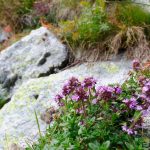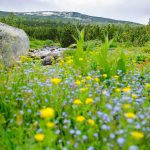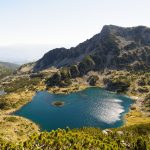When asked how many mountains are in our country, many will be surprised. In fact, according to a famous mountaineering list, there are forty-two of them. Among them, on a majestic pedestal, are the three national parks: Rila, Pirin and Central Balkan. Their total area is 193,049 ha. as such they rank among the largest and most valuable protected areas in Europe. National parks are managed by Directorates subordinate to the Ministry of Environment and Water. Their goal is to preserve the unique natural wealth and natural ecosystems, a refuge of rare plants and animals.
Rila National Park
 The Rila National Park is the largest national park in Bulgaria received its protected status in 1992. Its area is 81,046 ha, covering the central and highest parts of Rila. The management of the park is located in Blagoevgrad. Its territory is divided into nine sections with corresponding operational points in the settlements: Blagoevgrad, Belitsa, Yakoruda, Belovo, Kostenets, Borovets, Beli Iskar, Govedartsi and Dupnitsa.
The Rila National Park is the largest national park in Bulgaria received its protected status in 1992. Its area is 81,046 ha, covering the central and highest parts of Rila. The management of the park is located in Blagoevgrad. Its territory is divided into nine sections with corresponding operational points in the settlements: Blagoevgrad, Belitsa, Yakoruda, Belovo, Kostenets, Borovets, Beli Iskar, Govedartsi and Dupnitsa.
The highest peak is Musala /2925 masl/, 120 are clear mountain lakes. A larger part of the park’s territory is covered with centuries-old spruce, white mulberry and white pine forests. Of the higher plants established in Rila, 57 are endemic, 141 are medicinal plant species.
Rila National Park is inhabited by 2934 species of invertebrates and 172 species of vertebrates, 99 species of birds, 121 species of vertebrates listed in the Bulgarian Red Book, 20 species of amphibians and reptiles. Full-flowing and long rivers spring from Rila: Maritsa, Iskar and Mesta. It is no coincidence that the name of the mountain originates from the Thracian word “roula”, which means a lot of water. Rila National Park includes the “Parangalitsa”, “Central Rila Reserve” and “Skakavitsa” reserves.
The symbol of the park is the wild goat.
Central Balkan National Park
 It covers the highest parts of the Staroplanin massif. It covers an area of 71,669.5 ha. The directorate of the National Park is in the city of Gabrovo and the purpose of its work is to preserve and maintain the natural environment, biological diversity and wildlife, as well as to provide the necessary opportunities for scientific and educational activities, to support the natural livelihood of the local people and sustainable tourism. The territory of the Central Balkan National Park is divided into seven sections with offices in well-known historical towns: Troyan, Tzha, Ribaritsa, Stoykite, Karlovo, Kalofer and Klisura. There are seven reserves in the park: “Boatin”, “Tsarichina”, “Jendema”, “Steneto”, “Stara Reka”, “Kozia Stena”, “North Jendem”, “Singing rocks” and “Sokolna”.
It covers the highest parts of the Staroplanin massif. It covers an area of 71,669.5 ha. The directorate of the National Park is in the city of Gabrovo and the purpose of its work is to preserve and maintain the natural environment, biological diversity and wildlife, as well as to provide the necessary opportunities for scientific and educational activities, to support the natural livelihood of the local people and sustainable tourism. The territory of the Central Balkan National Park is divided into seven sections with offices in well-known historical towns: Troyan, Tzha, Ribaritsa, Stoykite, Karlovo, Kalofer and Klisura. There are seven reserves in the park: “Boatin”, “Tsarichina”, “Jendema”, “Steneto”, “Stara Reka”, “Kozia Stena”, “North Jendem”, “Singing rocks” and “Sokolna”.
The symbol of the Central Balkan National Park is the bear.
National Park Pirin
 The majestic mountain has been subject to special protection since 1962, when the highest and parts are included in the Vihren National Park. In 1974 the protected area was enlarged, and the name was changed to Pirin National Park. In 1998 the national park receives national status by being included in the UNESCO World Natural and Cultural Heritage list. The directorate of the park is housed in the city of Bansko. The area of the national park is 40,332 ha. The territory is divided into five sections: “Vihren” /with an office in Bansko/, “Kamenitsa” /with an office in Sandanski/, “Sinanitsa” /with an office in Kresna/, “Bezbog” /with an office in Dobrinishte/ and “Baiovi Dupki” /with office in Razlog/.
The majestic mountain has been subject to special protection since 1962, when the highest and parts are included in the Vihren National Park. In 1974 the protected area was enlarged, and the name was changed to Pirin National Park. In 1998 the national park receives national status by being included in the UNESCO World Natural and Cultural Heritage list. The directorate of the park is housed in the city of Bansko. The area of the national park is 40,332 ha. The territory is divided into five sections: “Vihren” /with an office in Bansko/, “Kamenitsa” /with an office in Sandanski/, “Sinanitsa” /with an office in Kresna/, “Bezbog” /with an office in Dobrinishte/ and “Baiovi Dupki” /with office in Razlog/.
The structure of Pirin National Park includes five types of landscapes depending on the natural components: rocks, relief, atmospheric air, climate, waters, soils, vegetation and animal life. They are: forest landscapes, rocky, lake, anthropogenic, water.
The top of the mountain is Vihren peak /2915m above sea level/. From the rocky peaks to the valleys, the mountain is streaked by thirty-five large and small cirques with 180 clear lakes of glacial origin. On the karst edges of the peaks, vegetation is sparse, but this is the realm of the chamois and the incredibly beautiful edelweiss.
Pirin is characterized by exceptional biodiversity. 1,300 species of higher plants have been established here, of which 18 are Pirin endemics. 229 species of vertebrates were discovered – 6 species of fish, 8 species of amphibians, 11 species of reptiles, 159 species of birds and 45 species of mammals.
In Pirin, the reserves have been announced: Bayovi dupki-Djinjirica /with an area of 2873 ha/, located between the peaks of Pirin and Banski Suhodol and Yulen /with an area of 3156 ha/, covering the Konarevo peak and the lake complexes: Vasilshki, Tipitski, Strazhi, Polezhanski and Disiliski lakes .
The symbol of Pirin National Park is the eagle. This is not accidental. On the one hand, the bald eagle, which is on the verge of extinction in Bulgaria, still nests in the rocky massifs of the mountain, and on the other hand, the line that describes the mountain massif above Bansko on the horizon, resembles an eagle with outstretched wings.
Mountains and people
Along with its priceless wealth, the mountain is also for the people who for centuries found shelter, protection, food and inspiration in its embrace. For this purpose, under the auspices of UNESCO as early as 1970. The beginning of building a world network of biosphere reserves as examples of harmonious coexistence between nature and man.
There are 16 biosphere reserves in Bulgaria. Of them, 7 are part of the national parks, namely:
In order to realize this natural connection between man and nature, biosphere reserves have a corresponding zoning:
- Core: with the highest nature protection status, with a ban on human intervention, a special area for scientific work and monitoring;
- Buffer zone: combining scientific work, educational activities, trained, recreational activities, high responsibility tourism and sustainable use of natural resources
- Transitional /outer/ zone: distinguished by agricultural activity, diverse forms of use of natural resources, tourism. The settlements are also located here. It is important for the economic and social development of the region.
Good practices combining nature, culture and ecotourism near Ruskovets:
These are places where people have preserved a sense of respect and reverence for nature. Without knowing the details of biosphere reserves, local communities have managed to find a way to use and conserve natural resources wisely, thus coming closest to the idea of a truly functioning biosphere reserve.
- The village of Dobarsko, where the eco-paths were built: “On the path of the Rila primrose”, “Path of the grouse”, “Strakaloto waterfall – “St. Virgin” – Ancient Roman Furnace”; The remarkable late medieval church “St. Theodore Tiron and Theodore Stratilat”, the revival church “Sretenie Gospodne”, the songs of the Dobar grandmothers and the preserved wedding rituals;
- Village of Gorno Draglishte: the “Pri Deshka” artisan workshop with delicious local feasts and old traditions;
- The village of Bachevo: the preserved traditions of horse breeding, the Kushiyas of Todorovden and Gergyovden, the paradise forests of Perivol, the sacrifice in the church of “St. Dimitar” on October 26, the culinary lessons for rolling out a pie and making a hollow
- City of Belitsa – the park for dancing bears
Reserves
Reserves are amazing places untouched by human hands. Complex Ruskovets Ski & Spa 4* is located in a hollow between Rila and Pirin. This convenient location will appeal to mountaineers and people whose favorite pastime is to observe and study the botanical and dendrological diversity, the beauty of butterflies, natural life without the self-confidence that man is the “crown” of nature.
- Bayuvi dupki – Jindezhritsa – the approach to it is from the Betelovoto area in the direction of the Yavorov hut. The Pirin National Park Directorate has built interesting eco-trails in the buffer zone such as: “Eagle’s Nest”, “Bear’s Den”, “Wild Goat Trail”, “Kingdom of Edelweiss”, Hajdushka Polyana”. The reserve protects the unique murky forests and a large number of relict plants
- Yulen– the reserve unfolds around the bed of the river Demyanitsa, with an approach from Bansko and Dobirnishte. It is distinguished by dense and impenetrable forests, beautiful lakes, secret places surrounded by impenetrable squats, where the master is the brown bear. In the buffer zone, the “Demyanishka river tells” eco trail has been built. You can visit the newly restored chapel “St. Teodor” in the area of Todorova Ornitsa.
- Oreljak – the highest peak in South Pirin, known for the old television tower. It is accessible from the remarkable village of Delchevo, hidden high in the Pirin mountains. The direction is to the city of Gotse Delchev. The objects of conservation and protection are reference primary beech forests, white wall forests, specific flora with limited distribution in the country, protected plant species. On St. George’s Day, the ritual of St. George’s cradles, thrown on amazing old trees, is still preserved.
- Ali Botush – in Slavyanka mountain. The direction is towards the city of Gotse Delechv, the starting points are from the native villages: Goleshovo, Nova Lovcha and Paril. The reserve protects the largest deposit of black moor and rare rocky mountain vegetation, numerous Mediterranean and sub-Mediterranean Balkan endemic and relict species.
- Kongura – in Belasitsa mountain. The direction is to Petrich. Kongura is the highest peak and border area of Bulgaria. The path is easy and pleasant, starting from Belasitsa hut. Here are the only preserved natural forest ecosystems of domestic chestnut and beech, as well as habitats of rare and endangered plant and animal species. The autumn months in the area are warm, and the local people organize a culinary chestnut festival in the village of Kolarovo.
- Parangalitsa – in Rila. Accessible from Bistrica village. Centuries-old virgin spruce forests, extremely valuable primary ecosystems of fir and white pine, a wealth of grassy and shrubby highland associations, rich animal life are preserved.
- Rilomanastir Forest – Primary forest ecosystems of coniferous and mixed fir and beech forests, habitats of rare and endangered species.
Bulgaria has its remarkable nature with unique pictures of mountains, valleys, hilly lands, valleys and wide fields, of rivers that rush or with dignity pass through the flow of time. You just need eyes to see her, a heart to love her and strength to protect her!

